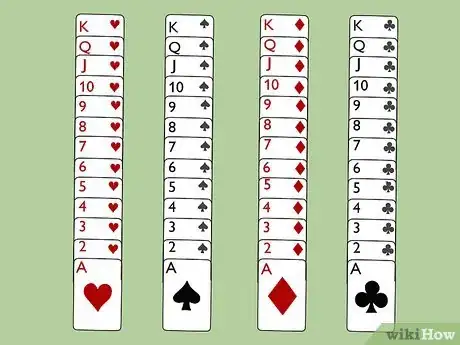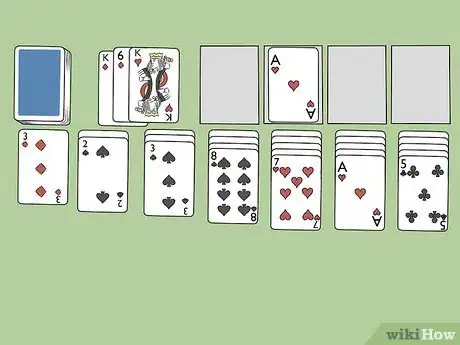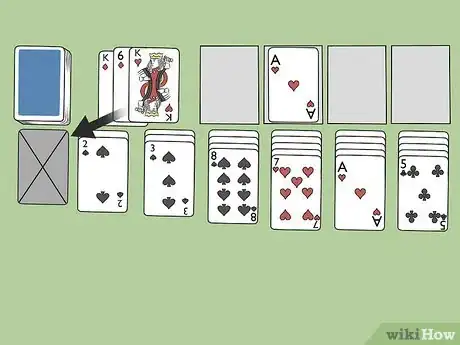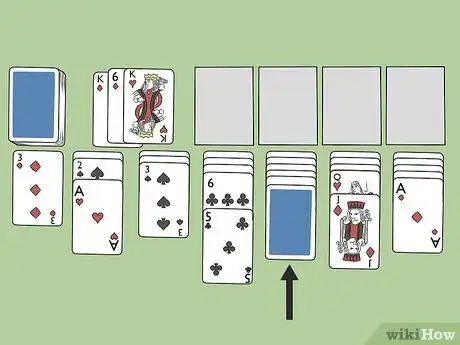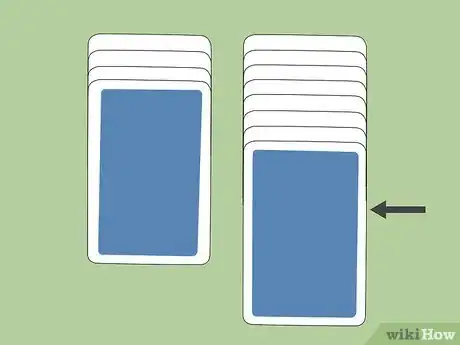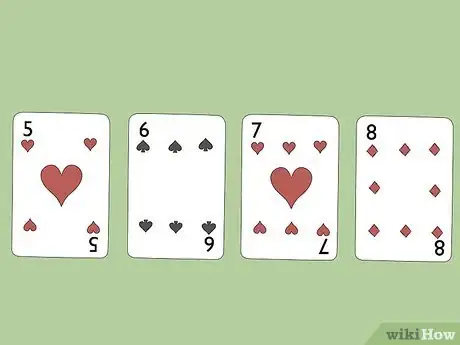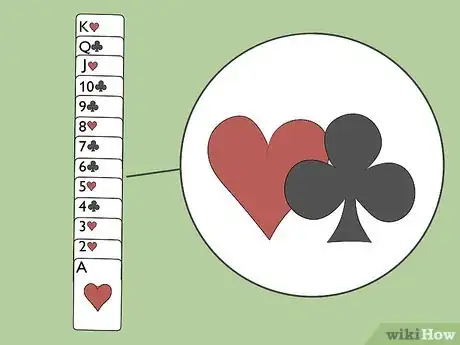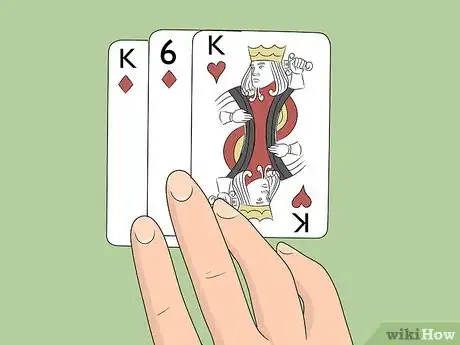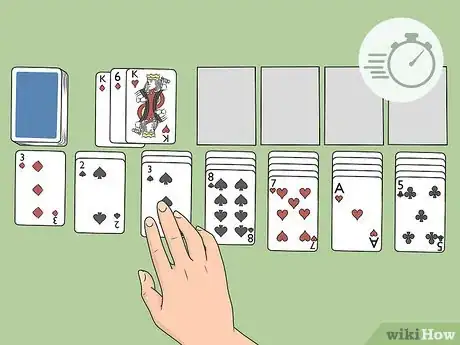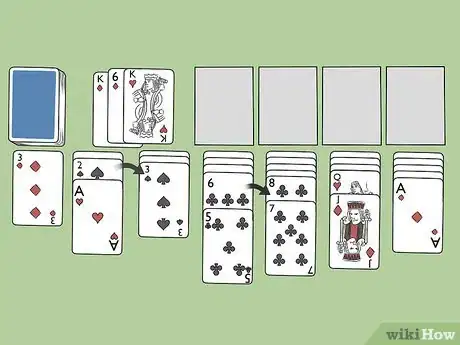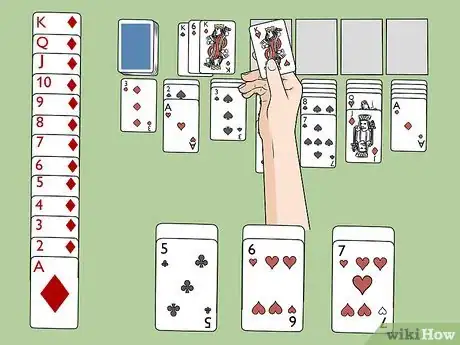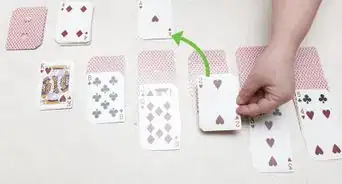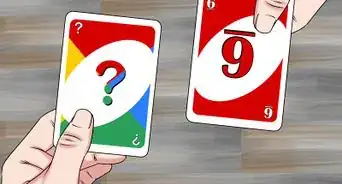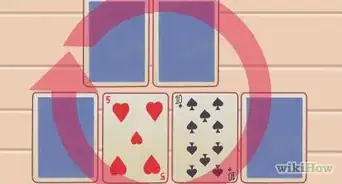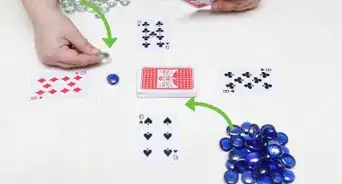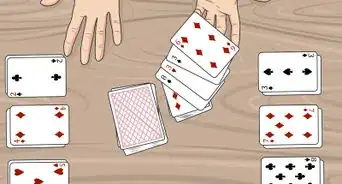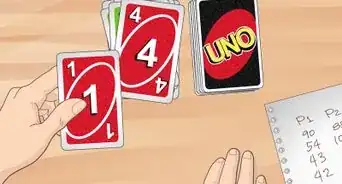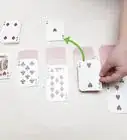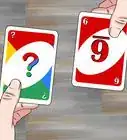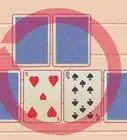This article was co-authored by wikiHow staff writer, Eric McClure. Eric McClure is an editing fellow at wikiHow where he has been editing, researching, and creating content since 2019. A former educator and poet, his work has appeared in Carcinogenic Poetry, Shot Glass Journal, Prairie Margins, and The Rusty Nail. His digital chapbook, The Internet, was also published in TL;DR Magazine. He was the winner of the Paul Carroll award for outstanding achievement in creative writing in 2014, and he was a featured reader at the Poetry Foundation’s Open Door Reading Series in 2015. Eric holds a BA in English from the University of Illinois at Chicago, and an MEd in secondary education from DePaul University.
This article has been viewed 38,970 times.
Learn more...
Solitaire is a single-player card game that uses a 52-card deck of playing cards. The player creates a board of upside-down cards and tries to move them into 4 piles based on the 4 suits. While not every game of solitaire is winnable, there are a couple different strategies that you can use to improve your odds of winning. Start the game right by immediately placing any aces or 2s into the piles at the top. While working through the deck and board, prioritize the upside-down cards, called downcards, over the cards in the deck at the top left. Keep your piles even and only move cards out of empty slots to play a king.
Steps
Starting the Game
-
1Win solitaire by creating 4 piles of sequential cards based on suit. If you’re playing timed solitaire, you win by quickly stacking cards into sequential piles and tallying up the score once you concede or finish piling the cards out. If you are playing standard or Vegas solitaire, you can only win by putting every card into the 4 piles on the top right based on the suit and order. Keep in mind that you will not be able to win every game—there could be a combination of cards that are buried and keep you from moving cards into the piles at the top.[1]
- The difference between standard and Vegas solitaire is that standard solitaire only reveals 1 card from the deck at a time. In Vegas solitaire, you reveal 3 cards every time.
- You can only make piles of cards on the board by using alternating colors. So 2 red cards can’t be stacked on top of one another.
- You can only put Kings on to a slot on the board if the column is empty.
-
2Look at the first card in the waste pile at the start to gain more information. The face-down deck in the upper left is called the stock and the cards that you flip over to the right to play from are called the waste pile. When the game starts, immediately flip your first card (or first 3 cards) over. The extra information will help you navigate your opening couple of turns.[2]
- For example, if you have a black 6 as the only card in the first pile and red seven in a different column, you’d normally wait until you have a king to fill the blank spot in. If there’s a king in the first waste pile though, you know that you can move that card immediately.
- Another scenario where the first card in the waste pile is important is if there is an ace. That would allow you to immediately play a 2 from the board, which may give you access to a playable downcard.
Advertisement -
3Put any Aces and 2s into the foundation piles before playing anything else. Before you start moving cards or flipping through the stock, look at every available card on the tableau to see if there are any aces you can move into the 4 scoring piles in the upper right, which are called foundations. Move all available aces into the foundations and check for any matching 2s. If you have any, go ahead and score them since they can only hinder your progress if they aren’t in the foundation.[3]
- The tableau refers to the 7 columns of available cards on the board that you can play. The upside-down cards in these piles are known as downcards.
- A 2 is never going to have another card put on top of it if it stays on the tableau. This means that it can only block you from playing others cards. A 3, on the other hand, could have a blocking 2 moved on top of it.
- Don’t score cards past 2 on your first turn unless they free up a downcard.
-
4Avoid freeing open slots on the tableau filed unless you have a king available. If you can free up an entire column on your tableau by either scoring all of the cards or moving them to another pile, wait until you have a king either in your waste pile or tableau. There’s no advantage to moving a card out of the way to free a slot unless there’s a king you can move to fill it and holding off will give you more options in the future.[4]
Tip: If you have choice between filling a slot on the tableau with a king from the waste pile or the board, choose a king from the board.
Freeing Downcards and Moving Stacks
-
1Flip downcards whenever you have more than one option. If the choice is between revealing a downcard and doing anything else, always flip the downcard. You can manipulate the waste piles to reveal new cards and you can rearrange stacks to get access to cards in the tableau piles, but you’ll never be able to reach the downcards if you don’t flip them.[5]
- Statistically, revealing downcards gives you access to a higher number of cards in the deck, which makes it easier to actually win.
-
2Work through your biggest stack of downcards if you have multiple plays. If you can reveal a downcard from several piles, start by revealing cards from the biggest pile first. This will give you the best opportunity at working through all of your downcards as the game progresses.[6]
- For example, if you have a stack of 3 downcards and a stack of 6 downcards, and both of them have a black 7 that you can move, opt to use the black 7 in the pile with 6 downcards.
Tip: The one exception to this rule is if you have a large set kings, queens, and jacks in your stock and a lot of empty columns on the tableau. In this case, work backwards and build out 4 piles from the kings first.
-
3Move 5s, 6s, 7s, and 8s carefully to avoid getting jammed. One of the easiest ways to get jammed, a term meaning that you’re stuck so that you can’t play any more cards in a pile, is to play the midrange cards (5-9) too quickly. You can put lower numbers into the foundation once you find the aces and you can move kings around on open slots to free up higher cards, but the midrange cards are highly likely to get stuck where they are. Try to only move these cards when you have no other plays to avoid trapping a pile.[7]
- It’s okay to move a 5, 6, 7, or 8 if you’re going to reveal a downcard.
-
4Make same-suit piles on an open board so you don’t get trapped. If you have access to a lot of cards on the tableau, make piles on the board that use the same suits. In other words, if you play the 9 of clubs on top of the 10 of hearts, try to add more clubs and hearts to the pile. This will solve stalled games where an ace is trapped under a column that you can’t move.[8]
- For example, if you only have the ace of spades and the ace of hearts in the foundation, you can flip clean through a patterned column made up of spades and hearts to get to the downcards underneath. If they aren’t in even patterns though, you won’t be able to reach the downcards.
- This is a lot easier to do if you’ve got access to the majority of the downcards and you have all the kings revealed.
-
5Move a black or red king to a free slot based on where the blocking cards fit. If you only have 1 free slot open on the tableau and you’re trying to figure out if you should place a black king or a red king, look at the top card on each column with remaining downcards. Select your king based on which one would be more beneficial to the cards that are blocking more downcards.[9]
- For example, if you have a red jack, red 8, black 7 and black queen blocking your downcards, a red king is a better choice for the free slot since all of those cards can be stacked on that king.
-
6Hold off on an unimportant move and flip through your waste pile. If you’re looking at the board and don’t see any additional moves that would reveal a downcard, free up a slot for a king, or score, go ahead and flip through the waste pile to see what cards you can play before you make the less impactful move. You may open up a new avenue of play that didn’t exist before you moved through the waste pile.[10]
- In general, you want to play cards from your waste pile after you’ve exhausted all of your other options, but if you aren’t going to reveal a downcard, score, or get access to a key card, flip through the waste pile first.
Scoring Effectively to Win
-
1Play cards quickly if you’re playing timed solitaire. At a casino, solitaire isn’t normally scored on time. But if you’re playing online or in a competitive tournament, your time likely contributes to your final score. Play cards quickly if you know that your time is going to contribute to the overall score in order to get a big bonus at the end of the game.[11]
- In timed solitaire, it is possible to beat an opponent that successfully completes the foundation piles even if you didn’t. It’s difficult, but possible.
Tip: Some versions of solitaire (usually online versions of the game) allow you to take cards from the foundation and put them back on the tableau so that you can move other cards. Doing this usually carries a penalty in timed solitaire.
-
2Distribute tableau piles evenly instead of trying to complete a single big pile. If you have the choice between maintaining 2 piles with 4 cards each and combining the piles to make 1 pile of 8, leave them separated unless you are going to reveal a downcard. Leaving smaller piles separated gives you a larger set of choices, especially when you’ve revealed every downcard and are working through the waste pile.[12]
- If you only have room for 2 long stacks, try to make them opposite of one another. In other words, if the king in the first pile is black, try to make the second pile start with a red king.
-
3Switch your strategy if you get stuck. If you find yourself struggling to reveal downcards or add cards to the foundation, change your strategy. There’s no use in sticking to a set of guidelines if you’re jammed. Go ahead and make that single pile, move all of the kings, and throw 5s, 6s, and 7s around to try and find your path to victory.[13]
- Not every game of solitaire is winnable. If you exhaust every possible option and end up racking your brain trying to find a move, you may simply be stuck in an impossible scenario.
References
- ↑ https://www.chessandpoker.com/solitaire_strategy.html
- ↑ https://www.chessandpoker.com/solitaire_strategy.html
- ↑ https://www.chessandpoker.com/solitaire_strategy.html
- ↑ https://www.chessandpoker.com/solitaire_strategy.html
- ↑ https://www.tb168gamecc.com/9/the-best-tips-and-tricks-for-how-to-win-at-solitaire-online/
- ↑ https://www.chessandpoker.com/solitaire_strategy.html
- ↑ https://www.tb168gamecc.com/9/the-best-tips-and-tricks-for-how-to-win-at-solitaire-online/
- ↑ https://www.tb168gamecc.com/9/the-best-tips-and-tricks-for-how-to-win-at-solitaire-online/
- ↑ https://www.tb168gamecc.com/9/the-best-tips-and-tricks-for-how-to-win-at-solitaire-online/
